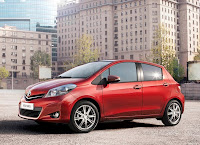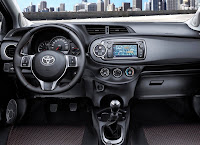Thursday, 20 September 2012
Road Test: Toyota Yaris 1.0 VVTI Luna
Price as tested: €15,895
+ Sharper looks, incredibly spacious, sweet engine, quality
– Cabin still a touch grey, silly specs: why no standard aircon or Bluetooth?
= Yaris rediscovers its old mojo
I still remember that morning. It was cool, but not cold, and a little overcast but still dry. It was early, traffic was pretty much non-existent and I had the twisting, rising and falling roads of the Dublin and Wicklow mountains to myself. And I was in a 1.0-litre Toyota Yaris.
Now, that might sound like the prelude to a let-down, but actually, I had fantastic fun. That first generation Yaris was just so beautifully balanced in its chassis, had terrific steering and a willing, rev-happy engine that I had one of the most enjoyable drives of my life. There’s a lot to be said for a car whose chassis is ten steps ahead of its power output; it means you can wring the best from the engine without actually breaking any laws or putting yourself in needless peril.
Fast forward one generation of Yaris and here came the let-down. The quality, space and terrific engine were all still there, but so was a cabin full of harsh, scratchy plastics and a chassis, steering and drivetrain combo that felt soulless compared to its brilliant predecessor. I hated it.
So this, the third generation Yaris, has rather a lot to prove. It has to, for me, expunge the memory of a lacklustre predecessor while evoking the brilliance of an older antecedent. Not easy that.
We’ll get to whether it can or not in a minute, but let’s start with the new Yaris’ party piece. Get in and set the drivers’ seat at a comfortable position for a six-foot-tall occupant. And then get out and sit in the back, behind that seat.
In most compact cars, that’s a recipe for knees in your ears and a hairdo in the rooflining, but not here. There is space; comfortable space. Space enough that I, both tall and broad would happily sit back there for some time. And it’s no trick. Get out again and open the boot and you are greeted with a big, flat expanse of some 285-litres. This is one spacious small car.
Up front, there’s an all new cabin design. Gone (thankfully) are the annoying small digital projector instruments and in come a set of handsome, clear analogue dials. In the centre of the dash, as long as you don’t go for the basic Terra specification, is the new 6-inch Toyota Touch multi-function screen, which controls and displays the radio, CD player, iPod connection, trip computer and, if you plump for the extra €550, the sat-nav. It looks neat, it looks classy and even the Yaris’ traditionally older buyer should be able to figure it out pretty quickly.
There are some interestingly textured surfaces and the chunky, almost flat-bottom steering wheel feels good to hold, but it must be said that the cabin is still a touch plain and grey (even more so on basic versions) and we cannot fathom why Toyota persists with such a big, clunky ignition key.
Under that stubby, squared-off bonnet (did we mention how crisply handsome this third generation Yaris looks?) lies, for most customers, a 1.0-litre three-cylinder petrol engine with 69bhp and 93Nm of torque. Thanks to Toyota’s Optimal Drive tech (low friction components, intelligent alternators etc etc) this little engine emits a similarly little 111g/km of Co2 and consumes a claimed average of 4.8-litres per 100km.
And it’s a sweetheart. Like all three-pots, it revs with a rumbly off-beat growl, zings happily around to its redline and, while you’d never describe it as quick (0-100kmh in 15.3secs) it is certainly willing. Keep the slick-shifting five-speed gearbox moving and you’ll do OK.
Now, here’s the big question, for me at any rate. Can the new Yaris blow away the memories of that dullard MkII and take me back to that mountainside blast? Yes it can. The steering is city-firendly light and free of anything you’d call feedback, but there’s a lovely accuracy and a friction-free feeling to the way to slides through your palms. There’s also been some common sense in terms of the suspension settings; it’s soft enough to absorb the worst bumps neatly, but with good damping that stops it feeling floppy and lumbering in the corners. In other words it feels exactly as a good small car should; agile, zippy and enjoyable. Not quite, I feel, as fluid as that exceptional original Yaris, but close and good enough to hold its head up against the likes of the Fiesta and Suzuki Swift.
And it’ll be safe too. Toyota is equipping all Yaris models as standard with VSC stability control, and you’ll get seven airbags (including a drivers’ knee airbag) whatever model you choose.
Generally, other equipment levels are quite good, but air conditioning is an expensive (€1,100) option on all but the expensive (€18,210) Sol top-spec model. Toyota says that’s down to customer feedback and poor sales for a previous standard aircon Yaris model, but it does seem a bit off-kilter to us. Mind you, there are good levels of equipment in other areas. Our mid-ranking Luna test car came with the Toyota Touch screen (which also incorporates a rear-view camera), all the safety kit, leather steering wheel, some nice chrome bits and Bluetooth phone connection, and all for slightly less than the equivalent old model Yaris Luna. Nice.
And while we’re on the subject of nice, the nicest thing about the Yaris is that it feels like all the car you’d ever, really, need. It’s spacious, beautifully made, enjoyable to drive, economical, good looking and, as long as you avoid that basic Terra spec, with sufficient toys to keep you entertained in the morning traffic jam. For me, it easily erases the disappointment of the last Yaris and yup, takes me back to that Mk1 sprint over the mountains. If it doesn’t sell by the bushel, I’ll be amazed.
Facts & Figures
Toyota Yaris 1.0 VVTi Luna 5-door
Price as tested: €15,895
Price range: €14,760 to €19,350
Capacity: 998cc
Power: 69bhp
Torque: 93Nm
Top speed: 155kmh
0-100kmh: 15.3sec
Economy: 4.8l-100km (61.5mpg)
CO2 emissions: 111g/km
Road Tax Band: A €104
Euro NCAP rating: Not yet tested
Subscribe to:
Post Comments (Atom)












No comments:
Post a Comment